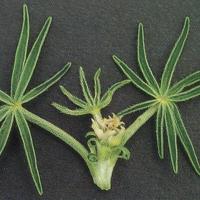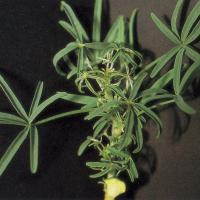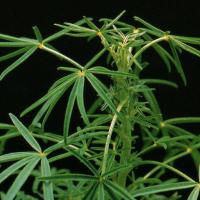Diagnosing boron deficiency in narrow-leafed lupins
Boron (B) deficiency is rare in most crops sown in Western Australia, but is more likely to impact broadleaf crops such as lupin and canola before cereals.
What to look for
- Plants appear dark green with distorted new growth; this is likely to occur on acidic deep sands or possibly sandy ironstone soils.
Paddock
- Roots are affected before the shoot. Profuse stubby laterals with a knobby end form on tap and secondary roots.
- New growth on the main stem and laterals is dark green and water-soaked. Leaflets are thickened and partially opened with a dark green midrib and fur-like edges.
- Shortened petioles on new growth result in a cluster formation.
- Leaflets become down-curved giving an umbrella effect.
- As deficiency progresses, new growth dies on emergence.
Plant
What else could it be
| Condition | Similarities | Differences |
|---|---|---|
| Diagnosing cucumber mosaic virus in narrow-leafed lupins | Stunted plants with small new leaves | Affected plants not limited to sandy acidic parts of the paddock. |
Where does it occur?
- Areas most at risk of B deficiency are sandy acidic sedimentary soils on the west coast that receive more than 600 mm annual rainfall - such as the sand plains of the Dandaragan plateau stretching from the West Midlands to the Eradu sandplain.
Management strategies

Spraying foliar

Top dressing

Lime application
- Lupin has yet to show shoot and grain yield responses to applied soil or foliar boron fertiliser
- However, if B deficiency is diagnosed, foliar applications act rapidly to minimise yield loss. Application timing is important to avoid irreversible damage.
- In future years if B deficiency is diagnosed by a crop tissue test, a soil application is recommended.
- Soil application generally lasts longer but can be leached from acidic, sandy soils. A major problem for boron is that the range of boron levels in soil for deficiency and toxicity for plant production is very small. Indiscriminate use of boron fertiliser will cause toxicity problems will be induced that are difficult to ameliorate.
- Liming increases soil boron availability.
How can it be monitored?

Tissue test
- As boron is immobile in the plant, young shoot sampling is the most accurate. The critical concentration for the youngest open leaflet before flowering is 12-15 mg/kg.
- Critical levels at the seedling stage are not reliable because having dry or acidic topsoil will reduce boron availability and as boron moves through the soil, higher levels may be present in the subsoil.
- There is no calibrated soil test for B deficiency in lupins. Soil testing may be useful on deep sands but subsoil testing for boron levels should also be conducted on duplex soils.
See also
Further information
Where to go for expert help
Page last updated: Wednesday, 6 May 2015 - 11:27am




